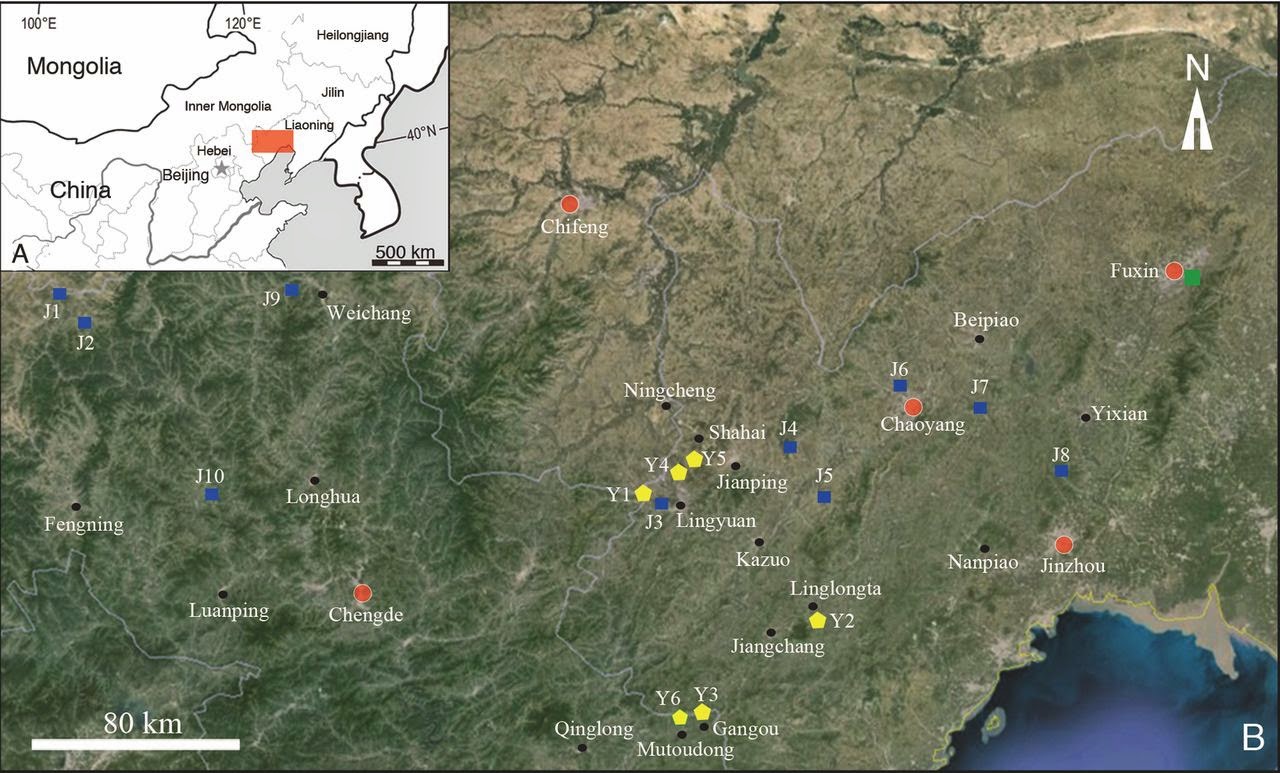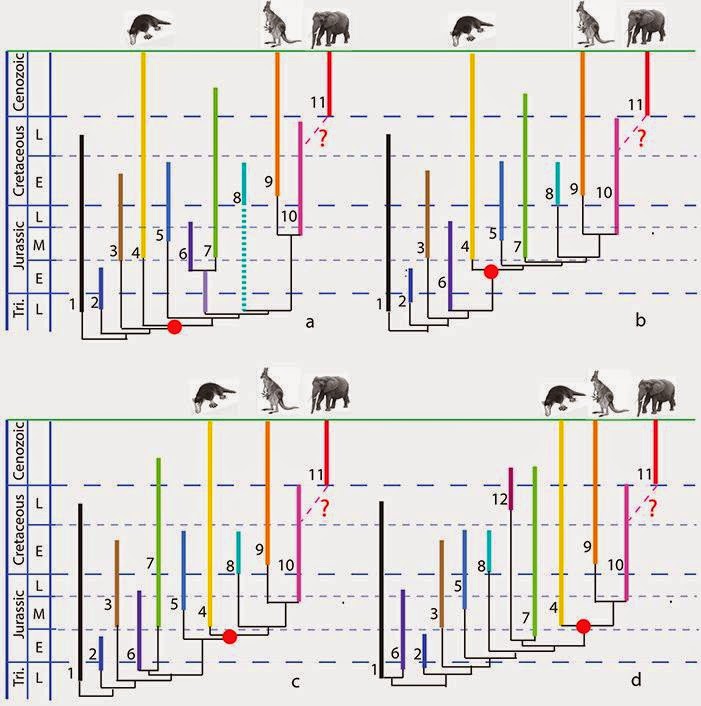
The most exciting findings covering Mesozoic mammals over the last two decades have come from the Jurassic and Cretaceous periods of China. Remarkably preserved fossils across nearly all major groups of Mesozoic mammals have provided a great amount of information about their morphology and biology. A researcher at the American Museum of Natural History reviews these discoveries and outlines potential future research efforts in the study of mammalian evolution.
It is generally accepted that the tree of life for mammals was rooted in the Mesozoic, but the specific time for the origin of mammals remains an issue of debate. This is partly because Mesozoic mammals are commonly known by fragmentary material, mostly dentitions, that restrained the search for the biology and evolution of our earliest ancestors.
During the last two decades, many Mesozoic mammals have been reported from all over the world. Notable among them are those from the southern continents, which have significantly enriched understanding of the morphology, diversity, geographic distribution and evolution of Mesozoic mammals. The most remarkable discoveries, however, have come from the Jurassic and Cretaceous periods of China; approximately 50 species, with most represented by superbly preserved skeletal specimens, have been reported. These discoveries have cast new light on some important issues in the study of Mesozoic mammals, such as the diversity and disparity, the mammalian affinity of “haramiyidans”, the divergence time of mammals and evolution of the mammalian middle ear.
Many issues regarding these findings are still being debated, and their resolution might depend on new discoveries and analyses. In a new study, Jin Meng, a scientist at the American Museum of Natural History in New York, reviews a spectrum of discoveries made surrounding the Mesozoic mammals of China. Meng, who is also based at the prestigious Institute of Vertebrate Paleontology and Paleoanthropology in Beijing, outlines these findings in an article titled “Mesozoic mammals of China: implications for phylogeny and early evolution of mammals” published in the Beijing-based journal National Science Review.

The study reviews most known Mesozoic mammals from China, which can be divided into several assemblages according to their geographic and temporal distribution; it also covers different evolutionary stages that are largely consistent with the global pattern of mammalian evolution. Also reviewed are varying hypotheses on the divergent times and phylogenetic relationships of Mammalia and its subgroups (Fig. 1), which in turn significantly affect interpretation of character evolution in early mammals.
The divergence time of Mammalia is directly associated with how the phylogeny of mammals is reconstructed, particularly with the phylogenetic placement of ‘haramiyidans’, a long-time puzzle in paleo-mammalian taxonomy and phylogeny. In light of the discoveries of several species that formed the clade Euharamiyida, the mammalian affinity of ‘haramiyidans’ was strongly supported by dental, cranial and postcranial features from these euharamiyidans. In the preferred phylogeny (Fig. 1a), Allotheria (‘haramiyidans’ and multituberculates) are placed within Mammalia, which best incorporated available evidence of morphology, temporal distributions and most phylogenetic analyses of known Mesozoic mammals and kept character parallelisms at the minimum between ‘haramiyidans’ and multituberculates, as well as between allotherians and other mammals. This hypothesis suggests that mammals originated in an explosive fashion during the Late Triassic because members of allotherians were found in beds of the Late Triassic.
As an example of character evolution of mammals, the study outlines the evolution of the mammalian middle ear, a classic issue of gradual evolution in vertebrates. All extant mammals have three middle ear ossicles: the malleus, incus and stapes. In addition, there is the ectotympanic that holds the eardrum. It has been known from developmental studies that the malleus is a composite element equivalent to the articular and prearticular, the incus is equivalent to the quadrate and the ectotympanic is equivalent to the angular bone. It is also known from the fossil record that during the evolution of mammals, the postdentary bones in the lower jaw of non-mammalian cynodonts were gradually reduced in size and eventually migrated to the middle ear. Research on eutriconodontans and ‘symmetrodontans’ from the Jehol Biota has provided evidence on the transitional mammalian middle ear (TMME), an immediate form between the mandibular ear and the definitive mammalian middle ear (DMME). The mandibular middle ear is a complex in which the ear bones are small but still attached to the tooth-bearing dentary bone so that these small bones have a dual function: mastication and hearing, as seen in Morganucodon. In the DMME the ear ossicles were completely detached from the dentary bone and migrated to the basal cranial region where they function exclusively for hearing. The TMME demonstrates that during the transition from the mandibular middle ear to the DMME, the postdentary bones were detached from the dentary but were not yet securely supported by cranial structures; instead they were anteriorly in articulation with an ossified Meckel’s cartilage whose anterior portion was loosely lodged in a groove on the medial side of the dentary bone. The embryonic condition of the middle ear in living mammals displays a similar morphology to the TMME and probably recapitulates the evolutionary stage of the mammalian middle ear.
Jin Meng also proposes a hypothesis on the evolution of the allotherians tooth pattern to show the potential for future studies based on the Mesozoic mammals discovered in China. The basic allotherian tooth pattern consists of two rows of multiple cusps in the upper and lower molars and is capable of a posterior, not transverse, chewing motion. This tooth pattern differs from those of other mammals that evolved from a ‘triconodont’-like tooth pattern to a tribosphenic tooth pattern. How the allotherian tooth pattern evolved has remained an enigma in the study of mammalian evolution. It is puzzling because wherever allotherians are placed in the phylogeny, either within or outside Mammalia, it is equally difficult to derive the allotherian tooth pattern from any known mammals or their close kin. Given the preferred phylogeny (Fig. 1a), which suggests that allotherians were derived from a Haramiyavia-like ancestor, and the occlusal pattern revealed by the euharamiyidans, it is proposed that the primitive allotherian tooth pattern, as represented by Haramiyavia, could have evolved from a ‘triconodont’-like tooth pattern and then gave rise to those of euharamiyidans and multituberculates, respectively.
Reference:
Jin Meng. “Mesozoic mammals of China: implications for phylogeny and early evolution of mammals.” National Science Review, doi: 10.1093/nsr/nwu070
Note : The above story is based on materials provided by Science China Press.










